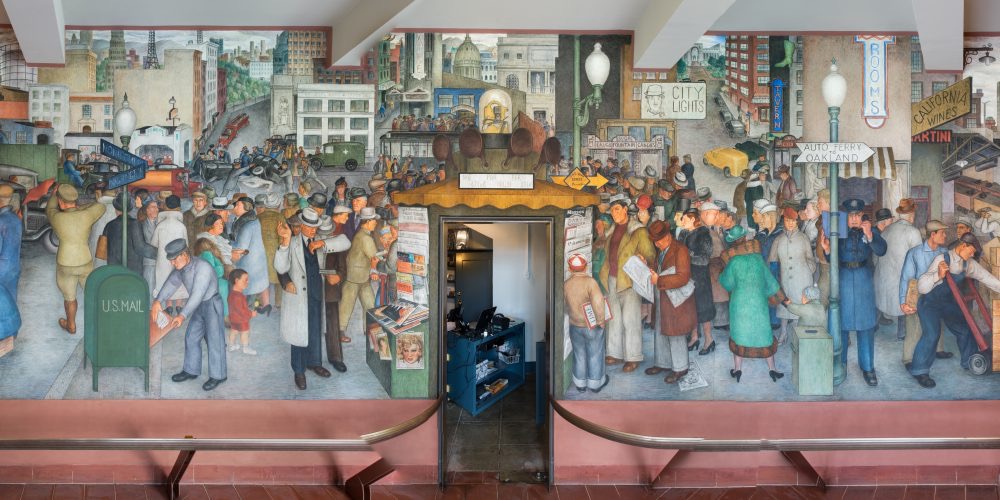SF_Oh

Coit Tower mural: Works Progress Administration, Telegraph Hill, San Francisco, California
Painters: Maxine Albro, Victor Arnautoff, Jane Berlandina, Ray Bertrand, Ray Boynton, Ralph Chesse, Rinaldo Cuneo, Ben Cunningham, Mallette Dean, Parker Hall, Edith Hamlin, George Harris, William Hesthal, John Langley Howard, Lucien Labaudt, Gordon Langdon, Jose Moya Del Pino, Otis Oldfield, Frederick Olmsted Jr., Ralph Stackpole, Suzanne Scheuer, Edward Terada, Frede Vidar, Clifford Wight and Bernard Zakheim. (1934)
"Light winds no clocks."
I first came to San Francisco seeking my future. I didn't find it there. Instead, I discovered a surprisingly immature city, one more suburban-seeming than New York City, one striving more than succeeding to seem European. It was impressively large and overwhelming. I couldn’t quite imagine myself unfolding there. I came home feeling like I'd been somewhere: Stanyon Street and Other Sorrows, Potrero Hill above the fog, the Golden Gate.
Rather than being a city that never slept, it seemed like one sleeping in, its ass end beneath the Marin Headland seeming to protrude halfway to China. I returned later with a new career, discovering my spot between training and consulting gigs. I actually worked there sometimes! I dutifully climbed Telegraph Hill each time to watch the sun rise or set and let the sense of place settle into me again. The Cafe Trieste impressed me; North Beach became my surreptitious home. I later connected with a Montgomery Street publisher and fulfilled my once-naive dream of becoming a published author. Nothing ever made me prouder than walking through that Jugendstil lobby feeling as though I actually belonged there. I had found my future for a time.
During the nineties tech rise, San Fran filled in. Those were the days when Union Square had no vacancies. I could still find a reasonably-priced room and my supper at Sam Wo's, where one entered through the cat-filled kitchen and dinner came up on a dumb waiter, Bring Your Own Beer. Gentrification eventually did him in, along with many funky little reasonably-priced hotels. Into the oughts, it got increasingly difficult to imagine thriving there. People without homes became ubiquitous, and every freaking corner featured a Starbucks or Peets, even the old brick Folger's building. I'd still visit, hiking up to the top of Telegraph Hill to see the murals, which seemed to stop time and hold it steady. I never felt more ready to inhabit my future than when I was standing up there.
The Muse and I escaped our future to visit where I once believed my future might reside. I never did live there, though the promise of finding my future there once proved useful in propelling me into the future I found. We return to the past to see if that lasted since my future refused to fully manifest here, though it was an able gatekeeper. I wander through predawn streets, seeking past coffee shops only to find boarded-up windows. This city seemed unstoppable through the nineties and into the oughts, the future incarnate. It looks considerably humbled now, more someplace that's settled for than any reasonable place to settle. It lacks the sparkle I found here just after the Summer of Love. Like all love, I suspect, its sparkle dispersed into the adjacent universe. Light inexorably moves toward its future without ever once inhabiting it. It only works when in motion and cannot ever actually discover itself. It moves at the speed of itself and forever remains timeless to everybody else, even to itself. Light winds no clocks on board. Neither does life.
©2024 by David A. Schmaltz - all rights reserved


